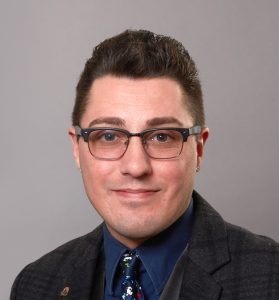
The novel results of exploring heuristics, induction, working backwards, symmetry—and each other
When she signed up for an honors seminar about problem-solving, math major Christina Sullivan ’20 was not expecting anything out of the ordinary. “The beginning of the semester focused on understanding different methods of problem-solving,” said Sullivan, who minored in statistics and data analytics. “That’s what I thought the whole course would be like.”

Salvatore J. Petrilli ’05, EdD, focuses his research on math education, the history of mathematics and applied statistical analysis. His article “The Mathematics Major Revision: An Adelphi Case Study” will appear in the Journal of Humanistic Mathematics in January 2021.
Salvatore J. Petrilli ’05, EdD, associate dean of the College of Arts and Sciences, who taught the seminar, explained to Sullivan and her 14 classmates that he had something more unusual in mind. As part of an experimental qualitative statistical project, they would be conducting independent research, creating their own assessment tools, exploring the different problem-solving techniques they had learned and presenting their results to the class.
“This way, students would actually get to see how other people solve problems,” Dr. Petrilli said. “They would gain a real appreciation that everybody solves problems differently.” He also knew many of his students were planning to become math teachers. “A new teacher goes into the classroom thinking that the way they solve a problem is the way everyone solves a problem. Here, they would learn that there isn’t just one way.”
While this was already an ambitious project for a 1-credit course, Dr. Petrilli decided to take it a step further: The class would write up their findings in an article and submit it for publication in a peer-reviewed academic journal. “They were excited, but a lot of them were skeptical,” he recalled. “They said they were too young and didn’t have the experience they needed to be published.”
However, Sullivan and her fellow students accepted the challenge—and met it. “Students Studying Students and Reasoning about Reasoning: A Qualitative Analysis” was published in January 2020 in the Journal of Humanistic Mathematics, co-authored by Dr. Petrilli along with Grant Clark ’19, Nicholas DeMarco ’19; Jack Esposito ’19, MA ’20; Brianne Giuliano ’19, MA ’20; Sara Greiss ’18; Emily Harris ’18, MA ’19; Alessia Merritts ’19; Kyle Murray ’18; Mateusz Piekut ’18; Brian Seidl ’19; Scott Shannon ’19; Nicole Silva; Christina Sullivan ’20; Brittany Willoughby ’18; and Yile (Jireh) Zhou ’18.
“As an undergraduate, I already had an academic paper under my belt,” Sullivan said. “That’s not something I’d ever expect.” Other students called the experience “eye-opening” and “life-changing.” One reported that it changed his career trajectory, convincing him to apply to graduate school and become a college math teacher.
Students “rose to the challenge”
Having offered the honors seminar several times already, Dr. Petrilli now sought a different way to teach problem-solving. Many studies—including those by George Pólya, PhD, the eminent mathematician who authored the seminar’s foundational text, How to Solve It (Princeton University, 1945)—present various pedagogical options. But, Dr. Petrilli started to wonder, could students learn to solve problems by observing how others solve problems?
The first half of the semester would remain the same, with Dr. Petrilli teaching the various problem-solving techniques Dr. Pólya outlined in his book, followed by a week devoted to qualitative trend analysis. The second half would be led by the students themselves, who would design experiments, enlist participants and analyze their data. “Students knew they couldn’t treat this like a 1-credit course,” Dr. Petrilli said. “To get the most out of it, they had to treat it like a 3-credit course. And they rose to the challenge.”
At the beginning of the semester, students were split into four groups, each assigned a specific problem-solving technique: heuristics, induction, working backwards and symmetry. Each group developed their own assessment tools to evaluate their assigned technique. “Students had the most difficulty crafting the right type of problem and figuring out exactly what they were looking for,” Dr. Petrilli said. “Once they got that done, everything seemed to flow.”
Testing diverse methods leads to surprising conclusions
Jack Esposito, who earned his master’s degree in adolescent education, was assigned to the heuristics group. Heuristics is a problem-solving technique based on intuitive thinking, similar to an educated guess. It speeds up the process of problem-solving and gives a satisfactory, although not necessarily perfect, result.
Esposito’s four-member team was careful to choose the kind of test that would give them the results they needed. “It took intensive researching,” he said. “We spent a lot of time talking with Dr. Petrilli and others in the department about the most accurate way to test our problem-solving strategy.”
Esposito and his classmates put together a two-part study in which participants drawn from the mathematics department were asked to solve two geometry problems. In the first question, subjects were given the proportions of one right triangle and instructed to use that information to figure out the proportions of another. In the second question, they were given the values for two sides and one angle of a triangle and asked to find the area.
The participants were divided into two categories: juniors and seniors in one group and first-year students and sophomores in the other. While both groups easily solved the first question, the juniors and seniors were more likely to exhibit heuristic reasoning by using what they learned solving the first question as an aid in solving the second question.
Nicholas DeMarco was part of the team looking at induction, the process of solving easier problems to develop the skills needed to solve a more difficult problem. Their study’s 11 participants included math majors and math education majors.
The team selected two questions, one straightforward and one that required more advanced knowledge about induction. To their surprise, they found that math education majors scored slightly higher than math majors. Math education majors were also more inclined to write paragraphs explaining their thought processes.
DeMarco, who is now pursuing his doctorate in mathematics at Binghamton University, State University of New York, says the research taught him much about how students think. Although the math education participants “used fewer calculations and formulas—and more writing—to justify their answer, they were able to communicate the same methodology as using a simple formula and substituting values,” he noted.
One publication, many voices
As the semester progressed, the students began sharing the results of their research. The working backwards team discussed how math majors in their study developed a formula to devise their solutions, while computer science majors used methods similar to coding logic, including recursion and arrays. The symmetry team shared their difficulty in studying that method, as participants “mostly found ways around using symmetry to solve problems.”
“The students learned much more about problem-solving than by simply going through the various techniques,” Dr. Petrilli said. “Everyone in the class learned the techniques, but each group also became experts in the technique they were studying closely.” Students also gained insight into the psychology behind problem-solving as well as their own problem-solving abilities.
But as they began writing up their results, the students weren’t sure how to combine their 15 perspectives into a single article. “We decided that we wanted something to tie the whole paper together,” said Sullivan. “So we decided to include our own voices.”
“The editors of the journal really liked that you can hear the voices of so many students,” Dr. Petrilli said. “It was written in a scholarly manner, but they added their own personal touch to it.” Those voices come shining through in the finished article, from Sara Greiss’ enthusiasm about her classmates’ conclusions to EmilyHarris’ eagerness to find solutions to complex questions.
DeMarco, who resolved to earn his graduate degree after taking the seminar, believes the article has the potential to inspire students across disciplines. “It’s not only applicable to math,” he said. “Math allows us to solve complex problems in different ways. There are ways of coming up with solutions that we haven’t even thought about so far. It’s all about training different parts of your brain and expanding your skill set.”
Petrilli, S. J., G. Clark, N. DeMarco, J. Esposito, B. Giuliano, S. Greiss, E. Harris, A. Merritts, K. Murray, M. Piekut, B. Seidl, S. Shannon, N. Silva, C. Sullivan, B. Willoughby, and Y. Zhou. “Students Studying Students and Reasoning about Reasoning: A Qualitative Analysis,” Journal of Humanistic Mathematics, vol. 10, iss. 1, Jan.2020, pp. 181-213.